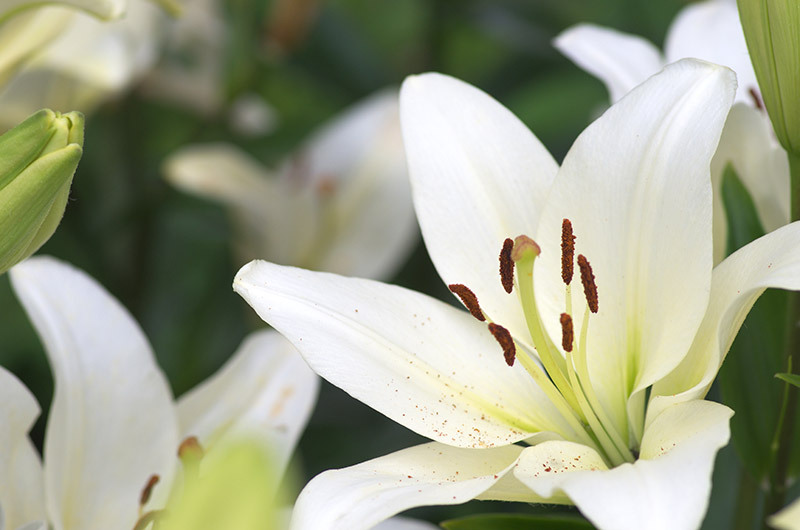Learn how to make your flowers last longer with these simple techniques
Posted on 25/08/2025
Learn How to Make Your Flowers Last Longer with These Simple Techniques
Fresh flowers can instantly uplift your living space, evoke positive emotions, and add splashes of color to any interior. However, keeping flowers looking beautiful for days or even weeks can be a challenge unless you know the right tricks. If you're searching for expert advice to make your flowers last longer, explore our comprehensive guide featuring simple techniques to extend the life of your bouquets and arrangements.

Why Do Cut Flowers Wilt So Quickly?
When flowers are harvested, they lose their natural source of hydration and nutrients. As soon as they are cut from the plant, the lifespan of their vibrant petals and crisp stems becomes limited. Environmental factors such as temperature, bacteria, humidity, and care routines can either shorten or extend a flower's life. Understanding why flowers wilt is the first step to learning how to keep flowers fresh longer.
- Lack of Water: Once cut, flowers no longer have roots to draw water, so dehydration sets in quickly.
- Bacterial Growth: Dirty water fosters bacteria, which block stems and prevent hydration.
- Temperature Extremes: High heat or cold accelerates wilting and petal drop.
- Nutrient Deficiency: After cutting, the absence of nutrients shortens the lifespan of blooms.
Key Principles for Making Your Flowers Last Longer
Whether you've received a romantic bouquet, picked wildflowers from your garden, or want to keep home arrangements fresh, these fundamental principles can be applied to all types of floral displays:
- Proper Hydration
- Stem Care
- Cleanliness
- Optimal Environment
- Nutritional Support
Let's break down each of these principles with actionable steps and easy techniques to help flowers last longer.
1. Hydrate Immediately After Receiving Flowers
As soon as flowers are delivered or harvested, they should be placed in water. Neglecting this step, even for a few hours, can dramatically reduce their longevity.
- Fill a clean vase with lukewarm water. Avoid using hot or very cold water, as it can shock the stems.
- Submerge the stems entirely in water for at least 30-60 minutes prior to arranging, especially if they've been without water for any period.
2. Give Stems a Fresh Diagonal Cut
Flowers absorb water through their stems. When stems are cut at an angle, it increases the surface area for water absorption and prevents the end from sitting flat at the bottom of the vase, which can block water intake.
- Use sharp, clean scissors or pruners and cut each stem at a 45-degree angle, ideally while holding the stem underwater to stop air bubbles from entering the stem.
- Recut stems every 2-3 days to keep water-uptake channels open as they close up over time.
- Remove any lower leaves that would be submerged in water to prevent rot and bacterial growth.
3. Start with a Clean Vase
One of the most overlooked ways to make flowers last longer is to ensure the vase is thoroughly clean before use. Bacteria from dirty containers are a main culprit in wilting and decay.
- Wash vases with hot, soapy water and a small amount of bleach or white vinegar to sterilize.
- Rinse thoroughly to ensure no cleaning residue remains, which could affect flower health.
4. Change the Water Regularly
Stale, cloudy water is a breeding ground for bacteria, shortening the life of your arrangement. For lasting bouquets, consistency is key!
- Replace the water every 1-2 days.
- Each water change is the perfect time to trim an extra 1-2 cm off the base of the stems for improved water uptake.
5. Keep Flowers Cool and Out of Direct Sunlight
Flowers thrive in cool environments. Heat accelerates aging, so where you place your vase matters for maximizing the lifespan of your bouquet.
- Avoid placing flowers in sunlit windows or near appliances that emit heat (like TVs or radiators).
- Move arrangements to the coolest room overnight; some people even use the fridge (except for tropical flowers).
- Keep flowers away from drafts, heaters, and air conditioners, all of which can dry out petals and stems.
6. Feed Your Flowers the Right Nutrients
Commercial flower food (often included with store-bought bouquets) contains a blend of sugar, acidifiers, and bactericides. If you're making your own solutions at home, follow these tips:
- Mix in the supplied flower food according to package instructions with each water change.
- If you don't have flower food, you can use a homemade mix: Combine 1 liter of lukewarm water, 2 teaspoons of lemon or lime juice, 1 teaspoon sugar, and 1/2 teaspoon bleach. The sugar feeds, the acid maintains pH, and bleach inhibits bacterial growth.
Special Tips for Making Different Types of Flowers Last Longer
Different flowers may require slightly different care to reach their full vase life potential. Here are a few handling suggestions for popular favorites:
How to Make Roses Last Longer
- Remove all leaves that fall below the waterline to prevent rot.
- Always cut stems underwater to avoid air blockages ("air embolisms").
- If a rose begins to droop, re-cut the stem underwater and float the rose head in warm water for 30-60 minutes for rapid revival.
How to Make Lilies and Tulips Last Longer
- For lilies, snip off pollen-filled anthers to prevent stains and prolong blooms.
- Tulips keep growing in water--trim every other day and avoid placing them in direct sunlight, which causes drooping.
How to Extend the Life of Hydrangeas
- Hydrangeas are thirsty--submerge their entire heads in water for an hour before arranging.
- Dip cut ends in alum powder (found in spice aisles) to enhance water uptake.
Common Mistakes That Cause Flowers to Wilt Faster
- Leaving Foliage in Water: This quickly leads to bacterial contamination.
- Not Recutting Stems: Blocked stems can't absorb water efficiently.
- Placing Near Fruit: Fruit emits ethylene gas, which accelerates flower aging. Keep arrangements far away!
- Ignoring Regular Water Changes: Old water quickly degrades flower health.
- Using Soft (Floppy) or Moldy Stems: Always remove affected flowers from your arrangement.
Advanced Tricks and DIY Flower Preservation Techniques
Bouquet Spritzing
Keep petals firm and hydrated by lightly misting the blooms with water every morning, especially in dry or heated households. This is especially helpful for hydrangeas and roses.
Refrigerate Your Flowers Overnight
If you want to maximize the shelf life of your flowers before a special event, place them in the refrigerator overnight (away from fruit, which emits ethylene gas). Cooler temperatures slow down aging considerably.
Try Aspirin or Vodka (with Caution!)
- Crushed aspirin is believed to lower water pH, deterring bacteria--try adding one tablet per quart of water.
- Vodka contains antibacterial properties--add a few drops (not more than a teaspoon per vase) to act as a preservative. Pair this with a spoon of sugar for energy.
Use Copper Coins or Bleach
- Adding a penny (made before 1982, when coins contained copper) can prevent fungal and bacterial growth.
- A pinch of bleach has the same effect (careful not to overdose).
Remove Wilting Flowers Promptly
As soon as a flower starts to wilt or rot, remove it from the bouquet. Dying blooms give off ethylene gas and bacteria that can quickly infect healthy stems and petals.
Flower Care FAQs: How to Make Flowers Stay Fresh Longer
- How long can cut flowers last?
It varies depending on species and care, but with proper methods, most cut flowers last 7-14 days. Some varieties like carnations and chrysanthemums may last 2-3 weeks. - Can I use soda to feed my flowers?
Yes! Clear sodas (like lemon-lime) with sugar act as homemade flower food. Add a quarter cup to your vase water to help blooms last longer. - Why do flowers die so fast in my home?
Common reasons include bacteria, lack of water, poor trimming practices, hot environments, or not using flower food.

Summary: Simple Steps to Prolong the Life of Your Flowers
- Hydrate new flowers quickly in clean, lukewarm water.
- Trim stems at a 45-degree angle and remove submerged leaves.
- Clean vases thoroughly before each use.
- Change water every 1-2 days and use appropriate flower food.
- Keep arrangements cool and out of direct sunlight.
- Re-cut stems and remove dead flowers regularly.
- Use home remedies like crushed aspirin, clear soda, or copper coins for a longevity boost.
Conclusion: Enjoy Fresher Flowers, Longer
Learning how to keep your flowers fresh for an extended period is both easy and rewarding. With these simple techniques to prolong the life of your flowers, you'll get more value from every bouquet and create vibrant, joyful spaces at home or at work. By prioritizing hydration, clean practices, regular maintenance, and a cool environment, you'll enjoy nature's beauty for many days to come.
Start using these proven methods today and experience the difference--your flowers will thank you!
Latest Posts
Unraveling the Mystery: Red Roses and Valentine's Day
Celebrate with the Best Birthday Blooms
Unveil the Sunflower Mysteries You Never Knew
Learn how to make your flowers last longer with these simple techniques






